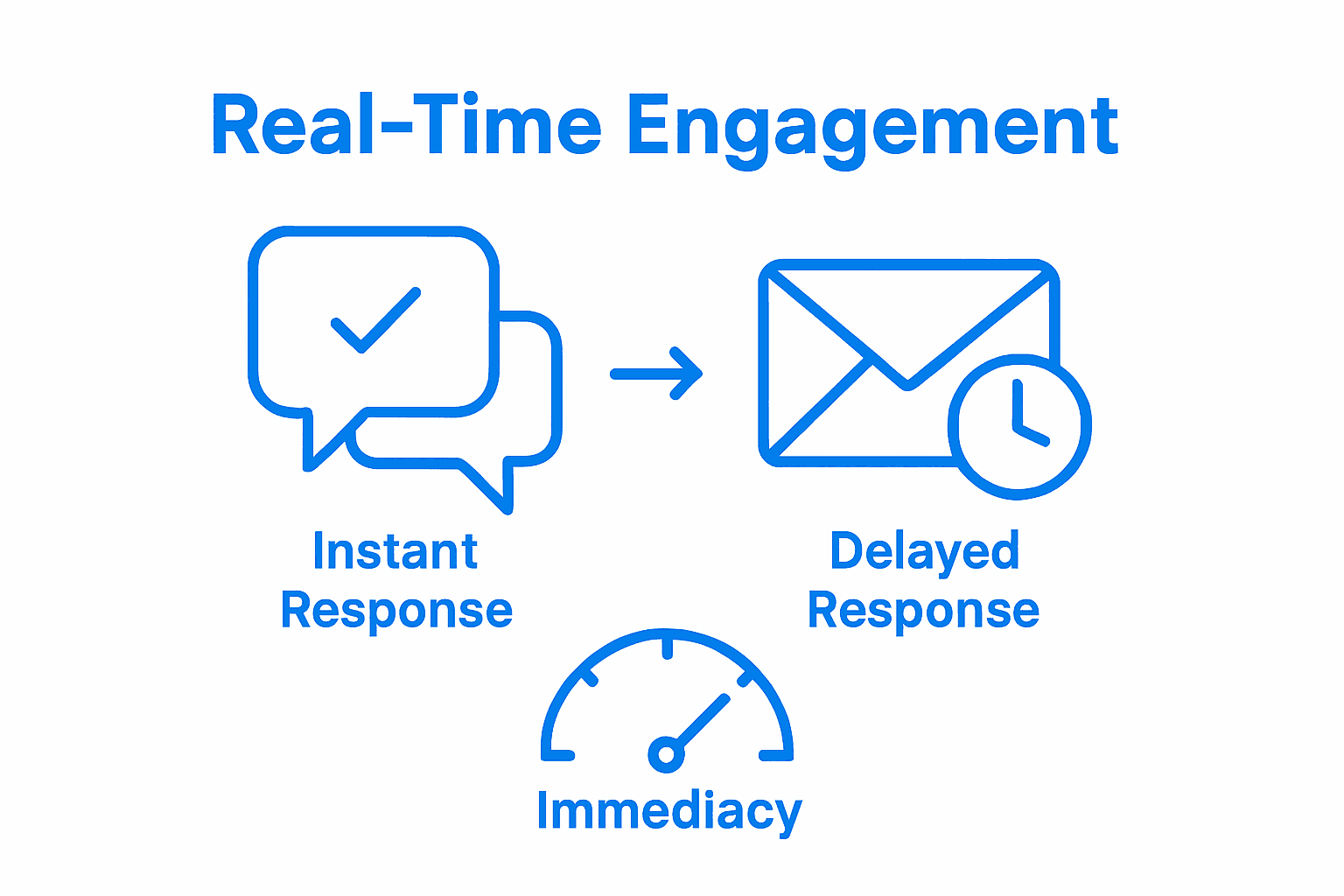Table of Contents
Real-time engagement is reshaping how we connect online and it is doing so at lightning speed. Platforms offering immediate interaction can see significantly higher user retention and engagement rates, making slow email threads look ancient in comparison. Most people think instant messaging is just a feature, but it’s actually the backbone driving more meaningful connections and even changing the way entire industries operate.
Table of Contents
- Defining Real-Time Engagement And Its Core Elements
- The Importance Of Real-Time Engagement In Online Interaction
- How Real-Time Engagement Enhances User Experience
- Key Technologies Driving Real-Time Engagement
- Real-World Examples Of Real-Time Engagement In Action
Quick Summary
| Takeaway | Explanation |
|---|---|
| Real-time engagement fosters immediate communication. | This interactive approach allows users to engage and respond without delays, enhancing their overall experience. |
| Technological foundations enable seamless interactions. | Technologies like WebSockets and WebRTC support dynamic communication, making real-time engagement possible across various platforms. |
| Instant feedback enhances user satisfaction. | Real-time engagement reduces communication gaps and allows users to feel valued through quick responses, leading to increased satisfaction. |
| Transformational impact on industries such as healthcare and education. | Real-time engagement facilitated remote consultations in healthcare and immersive learning experiences in education, changing traditional practices. |
| Economic benefits include higher user retention. | Platforms using real-time engagement experience greater user retention and involvement, translating to significant economic advantages for businesses. |
Defining Real-Time Engagement and Its Core Elements
Real-time engagement represents an interactive digital communication approach where users experience immediate, synchronous interactions across online platforms. Unlike traditional communication methods, real-time engagement creates dynamic connections that happen instantaneously, allowing participants to respond and interact without significant delays.
Below is a table summarizing the core elements and defining characteristics of real-time engagement, helping clarify what distinguishes it from traditional digital communication approaches.
| Element | Description |
|---|---|
| Immediacy | Enables instant, near real-time responses and exchanges |
| Direct Interaction | Supports immediate, person-to-person or group communication |
| Synchronized Communication | Allows participants to engage at the same time |
| Context-Rich Exchanges | Shares information that reflects current context and moments |
| Seamless Technology Integration | Utilizes advanced protocols for continuous, fluid experiences |
Understanding the Fundamental Characteristics
Real-time engagement is characterized by several key attributes that distinguish it from standard communication channels. Immediacy stands as the primary element, enabling users to receive and respond to information within seconds.
 This instantaneous nature transforms how individuals and businesses communicate, creating more responsive and interactive experiences.
This instantaneous nature transforms how individuals and businesses communicate, creating more responsive and interactive experiences.
The core elements of real-time engagement include:
- Direct Interaction: Enables immediate communication between users
- Synchronized Communication: Participants engage simultaneously
- Context-Rich Exchanges: Information shared reflects current moments and contexts
Technical Mechanisms Behind Real-Time Engagement
From a technical perspective, real-time engagement relies on advanced digital infrastructure like WebSockets, server-side event technologies, and robust network protocols.
Research from Interactive Communication Systems demonstrates how these technologies facilitate near-instantaneous data transmission, allowing platforms to create seamless, responsive user experiences.
The technological foundation supports multiple interaction types, including live messaging, video streaming, collaborative editing, and interactive virtual environments. By eliminating communication delays, real-time engagement transforms digital interactions into more natural, fluid exchanges that closely mimic face-to-face communications.
The Importance of Real-Time Engagement in Online Interaction
Real-time engagement has become a critical component of modern digital communication, transforming how people interact, share information, and build connections across various online platforms. Its significance extends far beyond mere technological convenience, representing a fundamental shift in how we communicate and experience digital interactions.
Enhancing User Experience and Connection
The primary value of real-time engagement lies in its ability to create more meaningful and immediate connections. Traditional communication methods often involve delays and asynchronous exchanges, which can diminish the sense of genuine interaction. Real-time engagement breaks down these barriers, allowing users to experience more authentic and responsive interactions that closely mirror face-to-face communication.
Key benefits of real-time engagement include:
- Instant Feedback: Users receive immediate responses
- Enhanced Emotional Connection: Reduces communication gaps
- Increased User Satisfaction: Creates more dynamic interaction experiences
Economic and Social Implications
Beyond personal interactions, real-time engagement has significant implications for businesses and social platforms. Economic Research on Digital Communication demonstrates that platforms offering immediate interaction generate higher user retention and engagement rates. This translates into tangible economic value, as businesses can create more responsive customer service experiences and users feel more connected to digital communities.
The social dimension of real-time engagement is equally transformative. By enabling instantaneous communication across geographical boundaries, these technologies are reshaping how communities form, interact, and share experiences. From collaborative work environments to social media platforms, real-time engagement allows individuals to connect, share, and collaborate in ways that were impossible just a decade ago.
How Real-Time Engagement Enhances User Experience
Real-time engagement revolutionizes digital interactions by creating more dynamic, responsive, and personalized user experiences. Unlike traditional communication models, this approach transforms how users perceive and interact with digital platforms, making connections more immediate and meaningful.
Psychological Impact of Instant Interaction
The psychological benefits of real-time engagement are profound. Immediate response mechanisms trigger positive emotional responses, reducing user anxiety and increasing platform satisfaction. When users receive instant feedback, they feel valued and understood, which significantly improves their overall digital experience.
Key psychological advantages include:
- Reduced Communication Anxiety: Minimizes waiting periods
- Increased Sense of Connection: Creates more authentic interactions
- Improved Emotional Responsiveness: Enables quicker emotional resolution
Technological Mechanisms of Enhanced Experience
Real-time engagement leverages advanced technological infrastructures to create seamless interactions. Research on Digital User Experience demonstrates how synchronous communication technologies enable platforms to provide instantaneous, context-rich interactions that feel natural and intuitive.
These technological mechanisms allow platforms to create personalized, adaptive user experiences that respond dynamically to individual user needs. From live chat support to interactive streaming features, real-time engagement transforms passive digital consumption into active, participatory experiences that feel more human and engaging.
Key Technologies Driving Real-Time Engagement
The landscape of real-time engagement is powered by sophisticated technological frameworks that enable instantaneous, seamless digital interactions. These technologies form the critical infrastructure allowing platforms to deliver responsive, dynamic user experiences across multiple digital environments.
Network Protocols and Communication Technologies
WebSocket technology emerges as a cornerstone of real-time communication, enabling bidirectional, full-duplex communication channels between clients and servers. This protocol allows continuous, low-latency data exchange that traditional HTTP connections cannot support, creating more responsive and interactive digital platforms.
Critical network technologies include:
- WebRTC: Enables direct browser-based real-time communication
- Server-Sent Events: Facilitates one-way server-to-client streaming
- Long Polling: Supports real-time updates through repeated connection requests
Advanced Communication Infrastructures
Modern real-time engagement relies on complex technological ecosystems that go beyond simple communication protocols. WebRTC Architectural Innovations demonstrate how peer-to-peer communication technologies are revolutionizing digital interactions, allowing direct, encrypted communication without intermediary servers.
These technologies support multiple interaction models, from live video streaming to collaborative document editing, by providing robust, low-latency communication infrastructures. The ability to transmit audio, video, and data simultaneously with minimal delay represents a significant leap in digital communication capabilities.
This table provides a comparison of the key technologies driving real-time engagement, summarizing their specific roles and functions within the digital communication landscape.
| Technology | Function | Use Case Example |
|---|---|---|
| WebSocket | Enables bidirectional, low-latency communication | Live messaging, collaborative editing |
| WebRTC | Direct browser-based real-time audio/video/data | Video chats, voice calls |
| Server-Sent Events | One-way streaming from server to client | Live notifications, news feeds |
| Long Polling | Repeated client requests to simulate real-time data | Chat updates, status alerts |
Real-World Examples of Real-Time Engagement in Action
Real-time engagement transforms theoretical technological concepts into practical, impactful experiences across multiple industries and social domains. By enabling instantaneous communication and interaction, these technologies are reshaping how individuals and organizations connect, collaborate, and solve problems.
Healthcare and Professional Services
Telemedicine platforms represent a powerful illustration of real-time engagement’s transformative potential.
 During global health challenges, these technologies allowed healthcare professionals to provide immediate medical consultations, diagnose conditions, and offer patient support without physical proximity. Medical Communication Research highlights how real-time video consultations became critical in maintaining healthcare accessibility during unprecedented times.
During global health challenges, these technologies allowed healthcare professionals to provide immediate medical consultations, diagnose conditions, and offer patient support without physical proximity. Medical Communication Research highlights how real-time video consultations became critical in maintaining healthcare accessibility during unprecedented times.
Key professional applications include:
- Remote Medical Consultations: Instant patient-doctor interactions
- Emergency Response Coordination: Rapid information exchange
- Collaborative Professional Meetings: Seamless global communication
Education and Learning Environments
Educational institutions have dramatically leveraged real-time engagement technologies to create interactive, immersive learning experiences. Virtual classrooms now enable students to participate in live discussions, collaborate on projects, and receive immediate feedback from instructors, transcending geographical limitations.
These technologies support dynamic learning models where students can interact directly with instructors and peers, creating more engaging and responsive educational experiences. From live coding sessions to interactive scientific demonstrations, real-time engagement is transforming traditional educational paradigms into more interactive, personalized learning journeys.
The following table organizes real-world industry examples to show how real-time engagement technologies are applied in different sectors, clearly highlighting specific use cases and benefits.
| Industry / Field | Real-Time Engagement Example | Primary Benefit |
|---|---|---|
| Healthcare | Telemedicine video consultations | Immediate diagnosis and support |
| Emergency Services | Rapid response communication | Quick coordination and decision-making |
| Professional Services | Collaborative virtual meetings | Seamless global collaboration |
| Education | Virtual classrooms and live discussions | Interactive, immersive learning |
Transform Your Real-Time Engagement With Fanspicy
Are you struggling to create genuine connections online or finding that delayed interactions hold your audience back? The article on real-time engagement explains how immediacy and responsive interaction are vital for meaningful digital experiences. Users expect instant feedback and authentic conversations—anything less feels outdated. This is where slow communication kills momentum and satisfaction drops. If you want your users to stay engaged and connected, you need a platform built for today’s demands.

Fanspicy gives creators and audiences instant, live access that mirrors natural, real-world interaction. Experience direct messaging, live cam features, and dynamic community tools that turn every visit into a lively event. Ready to build a truly interactive fanbase? Make the switch to Fanspicy. Your audience is waiting right now. Sign up today and let every moment on your platform feel alive. Visit https://fanspicy.com and unlock the power of real-time engagement.
Frequently Asked Questions
What is real-time engagement?
Real-time engagement is an interactive digital communication approach where users experience immediate, synchronous interactions across online platforms, allowing for dynamic connections without significant delays.
Why is real-time engagement important for online interactions?
Real-time engagement enhances user experience by creating more meaningful connections with instant feedback, reducing communication gaps, and improving overall user satisfaction in digital interactions.
What technologies enable real-time engagement?
Technologies such as WebSockets, WebRTC, and server-sent events are crucial for enabling real-time engagement, providing the necessary infrastructure for instantaneous, low-latency communication across digital platforms.
How does real-time engagement impact user satisfaction?
Real-time engagement positively affects user satisfaction by providing immediate feedback, reducing communication anxiety, and fostering a deeper emotional connection during interactions, making users feel valued and understood.
